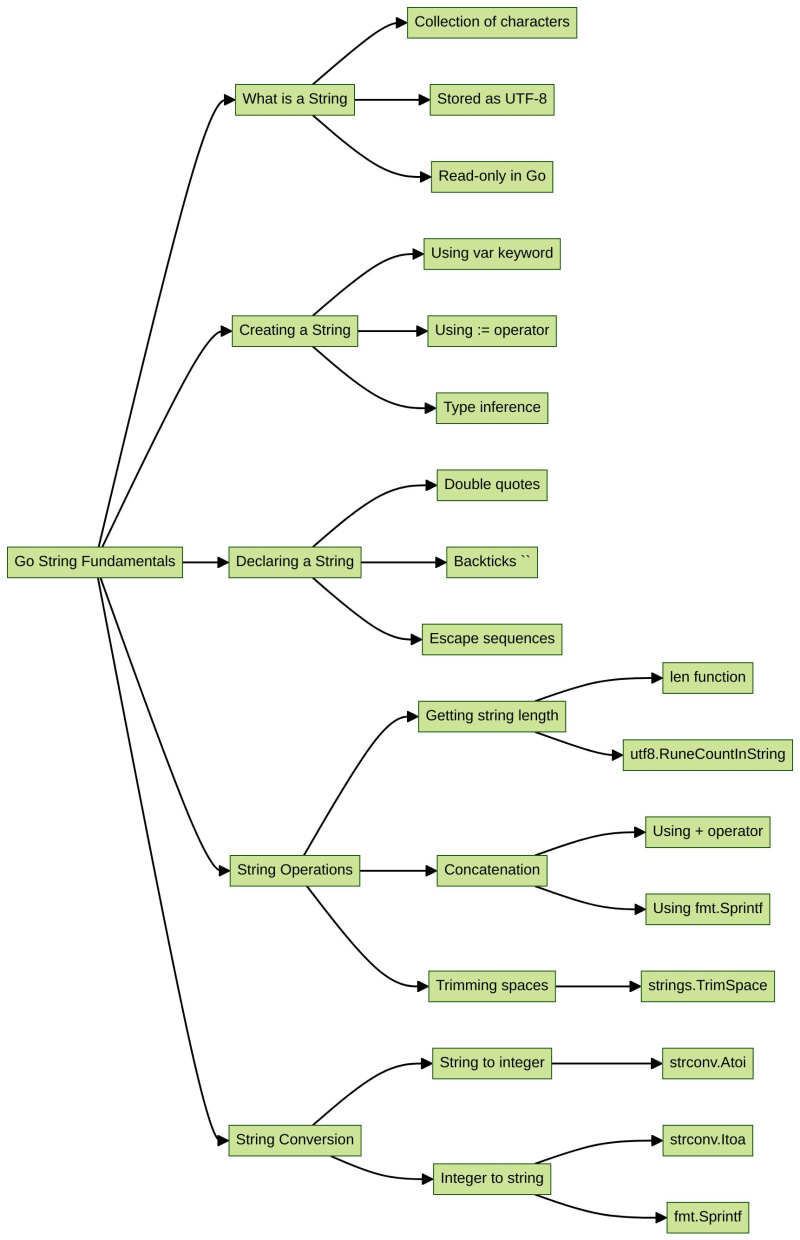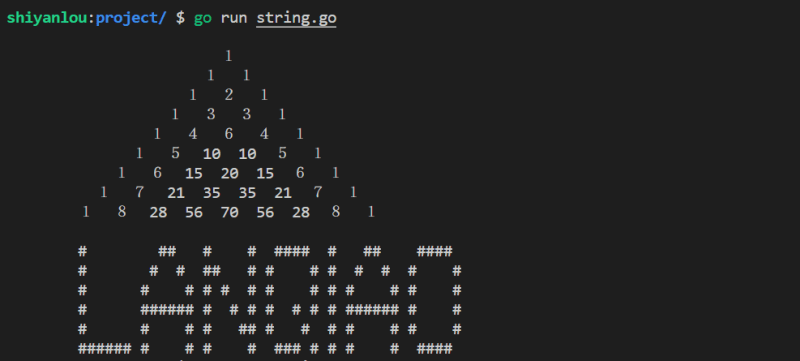介绍

在上一课中,我们了解到 go 中的字符使用 utf-8 进行编码并存储为 byte 或 rune 类型。现在,我们来谈谈字符串,它是字符的集合。一起来了解一下吧
知识点:
- 什么是字符串
- 创建字符串
- 声明一个字符串
- 常用字符串函数
什么是字符串
在我们用 go 学习的第一个程序中,我们打印了字符串 hello, world。
string 是 go 中的一种基本数据类型,也称为字符串文字。可以理解为字符的集合,占用一块连续的内存块。这块内存可以存储任何类型的数据,比如字母、文本、表情符号等
但是,与其他语言不同,go 中的字符串是只读的,无法修改。
创建字符串
字符串可以通过多种方式声明。我们来看看第一种方法。创建一个名为 string.go 的新文件:
touch ~/project/string.go
编写以下代码:
package main
import "fmt"
func main() {
// use the var keyword to create a string variable a
var a string = "labex"
a = "labex" // assign "labex" to variable a
// declare variable a and assign its value
var b string = "shiyanlou"
// type declaration can be omitted
var c = "monday"
// use := for quick declaration and assignment
d := "hangzhou"
fmt.println(a, b, c, d)
}
上面的代码演示了如何使用 var 关键字和 := 运算符创建字符串。如果用var创建变量时赋值,可以省略类型声明,如创建变量b所示。
预期输出如下:
labex shiyanlou monday hangzhou
声明一个字符串
大多数情况下,我们使用双引号“”来声明字符串。双引号的优点是可以用作转义序列。例如,在下面的程序中,我们使用 n 转义序列来创建新行:
package main
import "fmt"
func main(){
x := "shiyanlounlabex"
fmt.println(x)
}
预期输出如下:
shiyanlou
labex
以下是一些常见的转义序列:
| 符号 | 描述 |
|---|---|
| n | 新线路 |
| r | 回车 |
| t | 标签 |
| b | 退格键 |
| 反斜杠 | |
| ' | 单引号 |
| ” | 双引号 |
如果想保留文本的原始格式或者需要使用多行,可以使用反引号来表示:
package main
import "fmt"
func main() {
// output pascal's triangle
yanghuitriangle := `
1
1 1
1 2 1
1 3 3 1
1 4 6 4 1
1 5 10 10 5 1
1 6 15 20 15 6 1
1 7 21 35 35 21 7 1
1 8 28 56 70 56 28 8 1`
fmt.println(yanghuitriangle)
// output the ascii art of "labex"
ascii := `
# ## # # ### # ## ####
# # # ## # # # # # # # #
# # # # # # # # # # # # #
# ##### # # # # # # # ##### # #
# # # # ## # # # # # # #
##### # # # # ## # # # # ### `
fmt.println(ascii)
}
运行程序后,您将看到以下输出:

反引号常用于提示、html 模板以及其他需要保留输出原始格式的情况。
获取字符串的长度
在上一课中,我们了解到英文字符和一般标点符号占用一个字节,而汉字则占用三到四个字节。
因此,在go中,我们可以使用len()函数来获取字符串的字节长度。如果不存在占用多个字节的字符,可以使用len()函数来近似测量字符串的长度。
如果字符串中包含占用多个字节的字符,可以使用 utf8.runecountinstring 函数获取字符串中的实际字符数。
让我们看一个例子。将以下代码写入string.go文件:
package main
import (
"fmt"
"unicode/utf8"
)
func main() {
// declare two empty strings using var and :=
var a string
b := ""
c := "labex"
// output byte length
fmt.printf("the value of a is %s, the byte length of a is: %dn", a, len(a))
fmt.printf("the value of b is %s, the byte length of b is: %dn", b, len(b))
fmt.printf("the value of c is %s, the byte length of c is: %dn", c, len(c))
// output string length
fmt.printf("the length of d is: %dn", utf8.runecountinstring(d))
}
预期输出如下:
the value of a is , the byte length of a is: 0
the value of b is , the byte length of b is: 0
the value of c is labex, the byte length of c is: 5
the length of d is: 9
在程序中,我们首先声明了两个空字符串和字符串labex。可以看到他们的字节长度和实际长度是一样的
转换字符串和整数
我们可以使用 strconv 包中的函数在字符串和整数之间进行转换:
package main
import (
"fmt"
"strconv"
)
func main() {
// declare a string a and an integer b
a, b := "233", 223
// use atoi to convert an integer to a string
c, _ := strconv.atoi(a)
// use sprintf and itoa functions respectively
// to convert a string to an integer
d1 := fmt.sprintf("%d", b)
d2 := strconv.itoa(b)
fmt.printf("the type of a: %tn", a) // string
fmt.printf("the type of b: %tn", b) // int
fmt.printf("the type of c: %tn", c) // int
fmt.printf("the type of d1: %tn", d1) // string
fmt.printf("the type of d2: %tn", d2) // string
}
预期输出如下:
the type of a: string
the type of b: int
the type of c: int
the type of d1: string
the type of d2: string
在程序中,我们使用了fmt包中的sprintf()函数,其格式如下:
func sprintf(format string, a ...interface{}) string
format 是带有转义序列的字符串,a 是为转义序列提供值的常量或变量,... 表示可以有多个与 a 类型相同的变量。函数后面的字符串代表sprintf返回一个字符串。这是使用此功能的示例:
a = sprintf("%d+%d=%d", 1, 2, 3)
fmt.println(a) // 1+2=3
在这段代码中,format 传递了三个整型变量 1、2、3。format 中的 %d 整型转义字符被整型值替换,sprintf 函数返回替换后的结果,1+2= 3.
另外,请注意,当使用 strconv.atoi() 将整数转换为字符串时,该函数返回两个值,即转换后的整数 val 和错误代码 err。因为在go中,如果声明了变量,就必须使用它,我们可以使用下划线_来注释掉err变量。
当strconv.atoi()正确转换时,err返回nil。当转换出错时,err返回错误信息,val的值为0。你可以改变字符串a的值,将下划线替换为普通变量来尝试一下。
连接字符串
连接两个或多个字符串的最简单方法是使用 + 符号。我们还可以使用 fmt.sprintf() 函数来连接字符串。让我们看一个例子:
package main
import (
"fmt"
)
func main() {
a, b := "lan", "qiao"
// concatenate using the simplest method, +
c1 := a + b
// concatenate using the sprintf function
c2 := fmt.sprintf("%s%s", a, b)
fmt.println(a, b, c1, c2) // lan qiao labex labex
}
预期输出如下:
lan qiao labex labex
在程序中,我们还使用了 fmt 包中的 sprintf() 函数来连接字符串并打印结果。
从字符串中删除前导和尾随空格
我们可以使用 strings.trimspace 函数删除字符串中的前导和尾随空格。该函数接受一个字符串作为输入,并返回删除了前导和尾随空格的字符串。格式如下:
func trimspace(s string) string
这是一个例子:
package main
import (
"fmt"
"strings"
)
func main() {
a := " t n labex n t hangzhou"
fmt.println(strings.trimspace(a))
}
预期输出如下:
labex
hangzhou
概括
总结一下我们在本课中学到的内容:
- 字符串和字符的关系
- 声明字符串的两种方法
- 连接字符串
- 删除字符串中的前导空格和尾随空格
在本课中,我们解释了日常生活中使用的字符串。我们了解了字符串和字符之间的关系,掌握了字符串的创建和声明,并了解了一些常用字符串函数的知识。
在下一课中,我们将学习常量。
? 立即练习:go 弦乐基础知识
想了解更多吗?
- ? 学习最新的围棋技能树
- ? 阅读更多 go 教程
- ? 加入我们的 discord 或发推文@wearelabex



